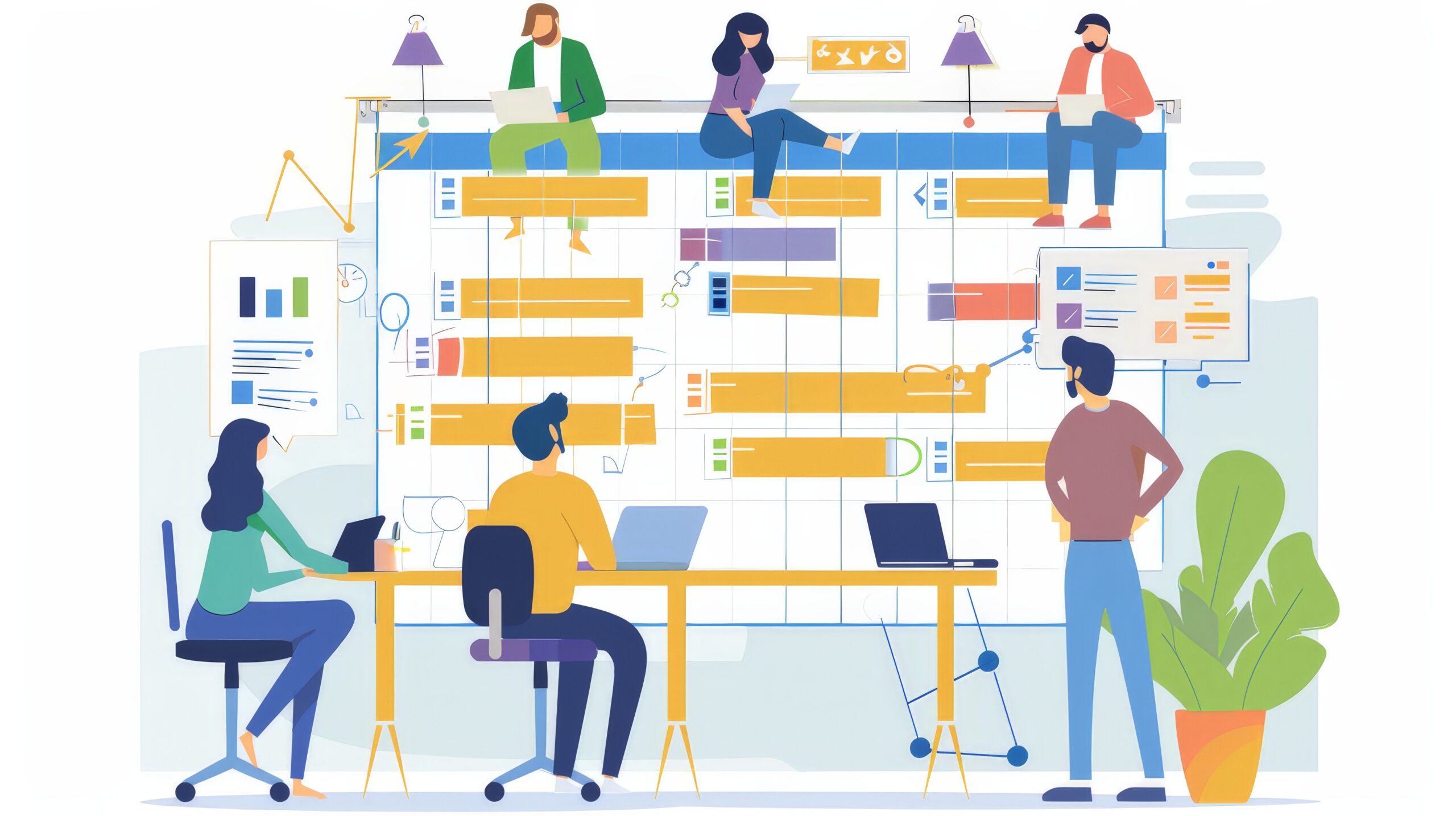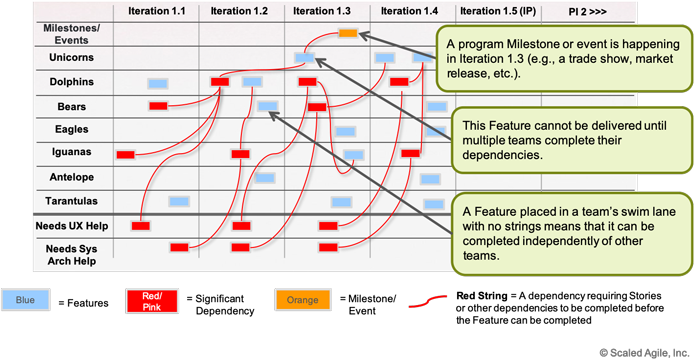Managing dependencies effectively is critical for ensuring smooth project execution and timely delivery of value. Dependencies, the interconnected relationships between tasks, teams, or components, can significantly impact the workflow and overall project success.
Within the Scaled Agile Framework (SAFe), the Release Train Engineer (RTE) plays a pivotal role in orchestrating these efforts. As a servant leader and coach for the Agile Release Train (ART), the RTE is instrumental in navigating and resolving dependencies among multiple teams.
This article delves into the intricacies of dependency management, focusing on best practices and tools relevant to Release Train Engineers (RTEs) working within the Scaled Agile Framework (SAFe).

Understanding Dependencies in Agile
Dependencies in Agile refer to situations where a task, team, or component relies on another to proceed. These dependencies can create bottlenecks and delays if not managed properly. In SAFe, where multiple teams work in a coordinated manner, understanding and handling dependencies is even more critical.
Why Do Dependencies Crop Up in Agile Projects?
Dependencies are a common occurrence in Agile projects, particularly within the Scaled Agile Framework (SAFe). They can emerge for a variety of reasons, often reflecting the complexity and interconnectivity of modern software development environments. Understanding why dependencies crop up is crucial for effectively managing them. Here are the primary reasons dependencies arise in Agile projects:
1. Interconnected Components and Systems
- Modular Architecture: Modern software systems are often designed with modular architectures, where different components or services interact with each other. This modularity can lead to dependencies as changes or developments in one module may impact others.
- Microservices: In a microservices architecture, each service may depend on other services to function correctly. Changes or issues in one service can affect others, creating a web of dependencies.
2. Cross-functional Teams
- Specialized Skills: Agile teams are typically cross-functional, meaning they comprise members with various specialized skills. Dependencies arise when a task requires input from multiple team members with different expertise.
- Shared Resources: Teams often share resources such as environments, tools, or specific skill sets. Limited availability of these shared resources can create dependencies and bottlenecks.
3. External Dependencies
- Third-party Vendors: Integration with third-party vendors or services can introduce dependencies. For instance, a project might rely on an external payment gateway, API, or library, which can affect the project timeline if not managed properly.
- Regulatory and Compliance: Projects that need to comply with regulatory standards may depend on approvals or audits from external bodies, leading to potential delays and dependencies.
4. Concurrent Development Efforts
- Multiple Teams: In a SAFe environment, multiple Agile teams often work concurrently on different parts of the same project. Dependencies can arise when these teams need to coordinate their efforts, especially if their tasks are interrelated.
- Sequential Work: Some tasks naturally follow a sequence where one cannot begin until another is completed. This finish-to-start dependency is common in many development workflows.
5. Technical Debt
- Legacy Systems: Working with legacy systems can introduce dependencies, as new features or updates may depend on older code that is complex and difficult to modify.
- Refactoring Needs: Refactoring or improving existing code can create dependencies, as changes in one part of the system may require updates or adjustments in other areas.
6. Business and Market Changes
- Changing Requirements: Agile projects are characterized by their responsiveness to changing business needs. As requirements evolve, new dependencies can emerge, requiring teams to adapt quickly.
- Market Conditions: Shifts in market conditions can necessitate changes in project priorities, leading to new dependencies as teams adjust their focus and resources.
7. Integration Points
- Integration Testing: Integrating different components or systems requires thorough testing to ensure they work together seamlessly. Dependencies can arise during integration testing when issues need to be resolved collaboratively.
- Continuous Integration/Continuous Deployment (CI/CD): The CI/CD pipeline itself can introduce dependencies, as teams need to ensure that their code integrates smoothly into the main codebase without causing disruptions.
8. Resource Constraints
- Limited Personnel: When key team members are shared across multiple projects, their availability can create dependencies. Their input or approval might be required for progressing with certain tasks.
- Tool and Environment Availability: Access to specific tools or environments needed for development or testing can be a dependency, especially if these resources are limited or shared among multiple teams.

Types of Dependencies in Agile
Task Dependencies
- Finish-to-Start (FS): A task cannot begin until a preceding task is completed.
- Start-to-Start (SS): A task can start only when another task begins.
- Finish-to-Finish (FF): A task cannot finish until another task finishes.
- Start-to-Finish (SF): A task cannot finish until another task starts (rarely used).
Team Dependencies
Dependencies between different teams working on related aspects of a project. For example, the development team may need design assets from the design team before coding can commence.
Component Dependencies
Dependencies between various components or modules of a software system. For instance, a front-end application might require back-end services to be available for data retrieval.
Resource Dependencies
Dependencies related to the availability of shared resources like specific team members, tools, or environments.
External Dependencies
Dependencies on third-party vendors, regulatory approvals, or other external stakeholders. For example, integrating a third-party payment system might require an API key from the vendor.
Logical Dependencies
Dependencies based on business rules or logical sequences, such as generating a report only after data entry is completed for a given period.
Inter-team Dependencies
Dependencies arising when multiple Agile teams are working on interrelated features or components.
Best Practices for Managing Dependencies as an RTE
Identify Dependencies Early
As an RTE, ensure that all potential dependencies are identified during the Program Increment (PI) planning sessions. Utilize brainstorming, stakeholder interviews, and historical data reviews.
Prioritize Dependencies
Work with Product Owners and Scrum Masters to prioritize dependencies based on their impact on the program’s timeline and critical path.
Regular Communication
Facilitate regular communication between teams and stakeholders through daily stand-ups, Scrum of Scrums, and other coordination meetings to keep everyone informed about dependencies.
Visualize Dependencies
Utilize visual tools such as Gantt charts, dependency maps, or Kanban boards to make dependencies visible to the entire Agile Release Train (ART).
Build Cross-functional Teams
Advocate for forming cross-functional teams with all the necessary skills to minimize external dependencies, thereby reducing bottlenecks and enhancing collaboration.
Implement Dependency Buffers
Incorporate buffers in your schedule for critical dependencies to accommodate any delays without impacting the overall program timeline.
Leverage Continuous Integration and Delivery
Promote CI/CD practices within the ART to detect and address issues with dependencies early in the development cycle.
Use Agile Contracts
When working with external vendors or partners, use agile contracts that allow flexibility and quick adjustments based on project needs.
Refine and Adapt Regularly
Regularly refine and adapt your dependency management strategies based on feedback from retrospectives and PI reviews.
Employ Dependency Injection
In software development, use dependency injection to manage and resolve dependencies within the code, promoting better modularity and testability.

Tools for Dependency Management in SAFe
Jira: A robust Agile project management tool that tracks dependencies through issues and epics. It offers various plugins and integrations to enhance dependency management.
Microsoft Azure DevOps: Provides tools for CI/CD, project tracking, and dependency management with integrated boards, pipelines, and repositories.
Trello: A visual project management tool that uses boards, lists, and cards to track tasks and dependencies, suitable for smaller teams.
VersionOne: An enterprise Agile platform supporting dependency management with visual planning boards, dependency tracking, and reporting.
Miro: A collaborative online whiteboard tool that allows teams to visually map out dependencies and workflows.
GitHub Projects: Integrates with GitHub repositories to track issues, pull requests, and project milestones, helping manage dependencies in code and project tasks.
Smartsheet: Combines project management and collaboration tools to track dependencies, timelines, and resource allocation.
Confluence: A collaboration tool that integrates with Jira and other tools to document dependencies, meeting notes, and project plans.
Asana: A task management tool that allows teams to map out dependencies using its timeline and project views.
Targetprocess: A visual management tool for Agile teams that supports tracking dependencies across teams and projects.
Implementing Effective Dependency Management in SAFe
As a Release Train Engineer (RTE), your role in managing dependencies within the Scaled Agile Framework (SAFe) is crucial to ensure seamless coordination and timely delivery of value. Here’s a detailed guide on how to implement effective dependency management.
1. Facilitate PI Planning
One of the cornerstone responsibilities of an RTE is to facilitate Program Increment (PI) planning, a crucial event where all teams on the ART come together to plan their work for the upcoming increment.
- Preparation: Before PI planning, the RTE ensures that teams are well-prepared. This involves providing necessary training, aligning team objectives, and ensuring that dependencies are identified and documented.
- Execution: During the actual PI planning event, the RTE facilitates sessions where teams collaboratively plan their work. A significant portion of this event is dedicated to identifying and discussing inter-team dependencies. The goal is to ensure everyone is on the same page and potential conflicts are addressed upfront.
2. Engage in Continuous Planning
Continuous planning is essential for controlling dependencies and ensuring they are addressed proactively.
- Program Increment (PI) Planning: This is the cornerstone event in SAFe where teams align on the vision, set objectives, and identify dependencies. As an RTE, facilitate this event to capture and document all dependencies.
- Iteration Planning: During each iteration, work with Scrum Masters and Product Owners to revisit and update dependency maps. Ensure that any new dependencies identified are documented and addressed.
- Backlog Refinement Sessions: Regular backlog refinement helps in surfacing and addressing dependencies early. Encourage teams to analyze upcoming features and identify any dependencies that may impact their delivery.
- Dependency Tracking: Use tools like Jira, Azure DevOps, or VersionOne to track and manage dependencies continuously. Regularly review and update these tools to reflect the current state of dependencies.
3. Foster Transparency and Open Communication
Transparency and open communication are key to managing dependencies effectively in a large, complex environment like SAFe.
- Daily Stand-ups and Scrum of Scrums: Facilitate daily stand-ups and Scrum of Scrums meetings to provide a platform for teams to communicate their progress and highlight any new dependencies. This helps in early identification and resolution of issues.
- Regular Status Updates: Implement a process for regular status updates where teams report on the progress of their tasks and any blockers due to dependencies. Use these updates to keep all stakeholders informed.
- Visual Management Tools: Utilize visual management tools like Kanban boards, Gantt charts, or dependency maps to make dependencies visible to everyone in the Agile Release Train (ART). Ensure these visuals are updated regularly and accessible to all team members.
- Transparency in Objectives: Clearly communicate the program and team objectives so that everyone understands how dependencies align with the overall goals. This clarity helps in prioritizing and managing dependencies effectively.
4. Equip Teams with the Right Tools
Providing teams with the right tools and training is crucial for effective dependency management.
- Agile Project Management Tools: Equip teams with robust Agile project management tools such as Jira, Azure DevOps, or Trello. These tools help in tracking tasks, dependencies, and progress in real-time.
- Training and Workshops: Conduct regular training sessions and workshops on dependency management best practices. Ensure teams understand how to use the tools effectively and the importance of managing dependencies.
- Automation Tools: Leverage automation tools for continuous integration and continuous delivery (CI/CD). These tools can help detect and resolve dependency issues early in the development cycle.
- Documentation Tools: Use documentation tools like Confluence to create and maintain a repository of all dependencies. This central repository should be regularly updated and accessible to all team members for reference.
5. Encourage Collaboration and Accountability
Promoting a culture of collaboration and accountability ensures that teams take ownership of their dependencies and work together to resolve them.
- Cross-functional Teams: Advocate for forming cross-functional teams that have all the necessary skills to complete their work without relying heavily on other teams. This minimizes dependencies and improves efficiency.
- Collaborative Planning: Encourage teams to engage in collaborative planning sessions. Joint planning sessions, especially during PI Planning, help teams to understand interdependencies and devise strategies to manage them.
- Shared Goals: Foster a sense of shared goals and objectives among teams. When teams understand their success is interlinked, they are more likely to work together to resolve dependencies.
- Retrospectives: Use retrospectives to reflect on how dependencies were managed during the iteration or PI. Discuss what worked well and what didn’t, and identify actions to improve dependency management in the future.
- Responsibility and Ownership: Clearly define responsibility and ownership for managing specific dependencies. This ensures accountability and clarity about who needs to address and resolve each dependency.
- Problem-solving Workshops: Organize problem-solving workshops where teams can collaboratively address and resolve complex dependencies. These workshops can include brainstorming sessions, root cause analysis, and action planning.
Practical Steps for RTEs
To implement these principles effectively, consider the following practical steps:
Develop a Dependency Management Plan:
Create a comprehensive dependency management plan at the beginning of each PI. This plan should outline all known dependencies, their priority, and strategies for managing them.
Regular Dependency Reviews:
Schedule regular dependency review meetings with Scrum Masters and Product Owners to assess the status of dependencies and address any new ones that have arisen.
Escalation Paths:
Establish clear escalation paths for resolving dependencies that cannot be managed at the team level. Ensure that there is a mechanism for quickly escalating and resolving critical dependencies.
Use of Metrics:
Implement metrics to track the effectiveness of dependency management. Metrics such as the number of blocked tasks, time taken to resolve dependencies, and impact on delivery timelines can provide insights into how well dependencies are being managed.
Promote a Culture of Continuous Improvement:
Encourage a culture where teams are continuously looking for ways to improve dependency management. Regularly update practices and tools based on feedback and lessons learned.
Engage Leadership:
Ensure that leadership is engaged and supportive of dependency management efforts. Effective dependency management often requires support from higher levels of the organization to resolve cross-team and cross-departmental dependencies.
Additional Key Areas of Focus
Dependency Mapping
Visualizing dependencies is essential for effective management, and the RTE plays a key role in creating and maintaining these visual tools.
- Visualization: The RTE helps teams create and maintain dependency boards or maps. These visual aids track inter-team dependencies, making it easier to manage and resolve them.
- Synchronization: Regular updates to these maps ensure that all teams are aware of current dependencies and their status. This proactive approach helps in minimizing surprises and bottlenecks during the project lifecycle.

Coordinating with System Architects and Product Management
Effective dependency management requires close coordination with various stakeholders, including system architects and product management.
- Architecture Runway: The RTE collaborates with system architects to ensure that the architectural runway is adequate to support current and upcoming work. This proactive approach helps in addressing technical dependencies before they become roadblocks.
- Backlog Refinement: The RTE works with product management to ensure that dependencies are reflected in the product backlog and prioritized accordingly. This alignment ensures that teams can address dependencies as part of their planned work.
Managing Risks and Issues
An essential part of the RTE’s role is to manage risks and issues related to dependencies.
- RAID Logs: The RTE maintains a Risks, Assumptions, Issues, and Dependencies (RAID) log. This log is a critical tool for tracking and managing dependencies, ensuring they are addressed in a timely manner.
- Risk Mitigation: By identifying dependencies early, the RTE can work with teams to develop mitigation plans, reducing the impact of potential delays and disruptions.
Release Planning and Tracking
Ensuring that dependencies are managed effectively is crucial for successful release planning and tracking.
- Incremental Delivery: The RTE ensures that the release plan accommodates dependencies, allowing for incremental delivery of value. Continuous tracking of progress allows for necessary adjustments to be made promptly.
- Alignment: The RTE aligns team deliveries with program-level objectives, ensuring that dependencies do not hinder the overall progress of the Agile Release Train.
Continuous Improvement
Continuous improvement is a fundamental principle of Agile, and the RTE is a key facilitator of this mindset.
- Retrospectives: Regular retrospectives at both the team and program levels help identify areas for improvement in dependency management. The RTE facilitates these retrospectives and implements feedback to enhance the process.
- Best Practices: The RTE encourages the adoption of best practices and tools for dependency management. By fostering a culture of continuous improvement, the RTE helps teams become more efficient and effective over time.
Conclusion
Effective dependency management is a cornerstone of successful Agile and SAFe implementations. As a Release Train Engineer, your role in understanding and managing dependencies is pivotal. By engaging in continuous planning, fostering transparency and open communication, equipping teams with the right tools, and encouraging collaboration and accountability, you can mitigate risks, enhance collaboration, and ensure timely delivery of high-quality products. Continuous improvement in dependency management processes will lead to more efficient workflows and better project outcomes, ultimately driving greater business value.
By adhering to these best practices and utilizing the appropriate tools, RTEs can master the art of dependency management, leading their Agile Release Trains to success in delivering value consistently and efficiently.





